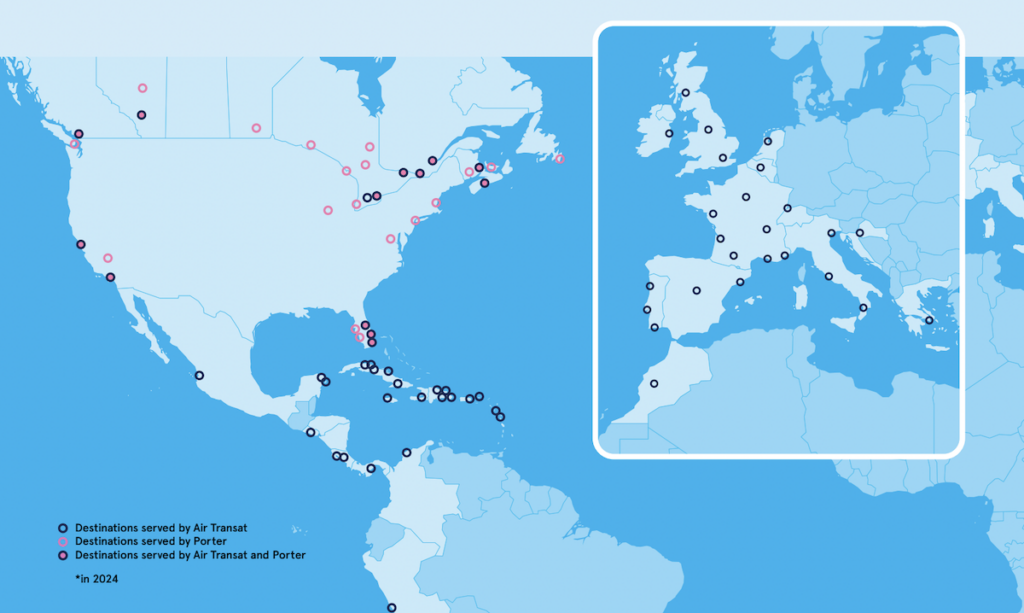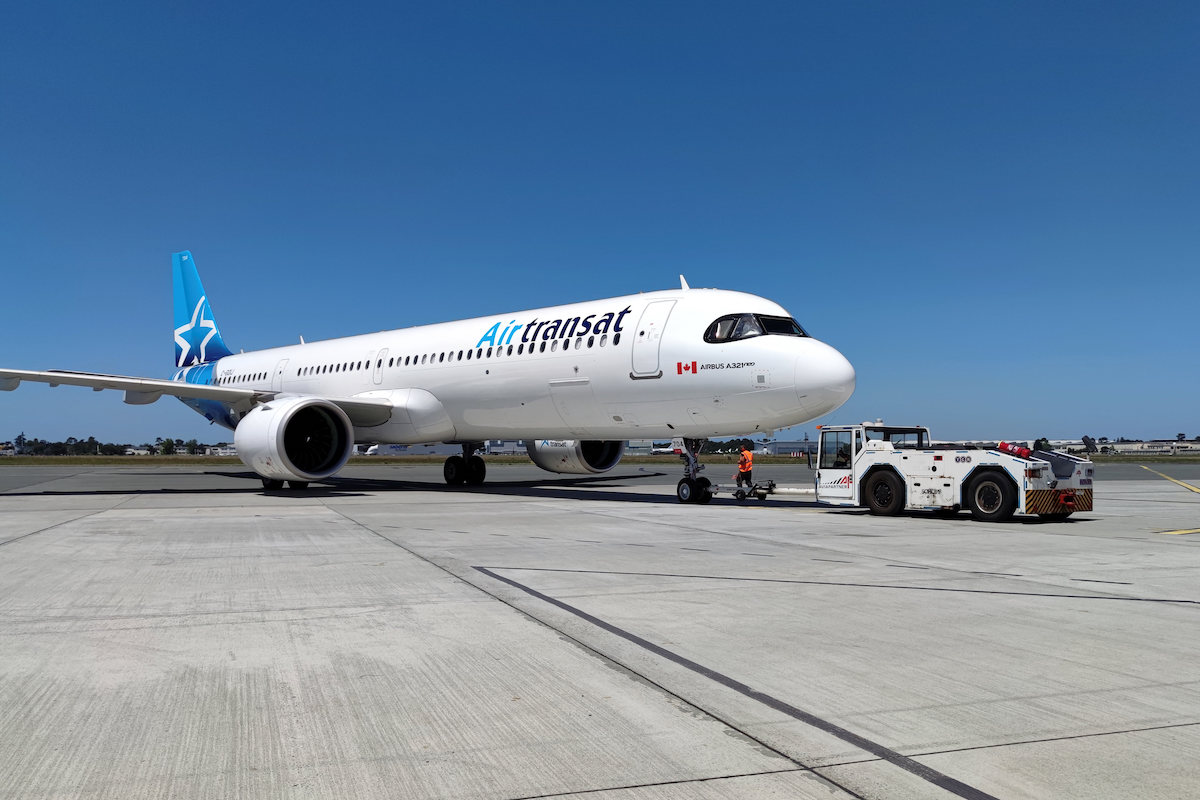Skift Take
Canada's Air Transat and Porter Airlines see themselves as stronger together under a planned new alliance.
It’s not a merger, but Air Transat and Porter Airlines plan a new joint venture that would allow the Canadian companies to join forces to grab a larger marketshare.
The pact unveiled Tuesday would allow Porter and Transat to coordinate routes, schedules, and fares across their networks. In short, it would allow the airlines to essentially merge their respective operations without the cost or hassle of actually combining. And, as Porter and Transat see it, it would enable future expansion while offering travelers “significant benefits,” including more flight options and easier connections.
Porter has orders for as many as 100 Embraer E195-E2s that it plans to fly on domestic Canada or U.S. routes.
Transat sees the tie up as a way to “accelerate the expansion of our transatlantic footprint,” said CEO Annick Guérard. The carrier doubled down on its core airline business and moved away from being an integrated travel company in 2021.
Stronger Competitive Position in Canada
The tie up would also allow Porter and Transat to better compete with market leader Air Canada. The Star Alliance carrier dominates the Canadian market with a 41% share of domestic and international seats this year, Cirium Diio schedule data show. Air Canada is the leading airline at both Porter’s Toronto base and Transat’s Montreal base.
“This is an incredible opportunity that has the potential to transform the competitive landscape in Canada,” Porter CEO Michael Deluce said on LinkedIn. “There will now be a stronger third option for consumers in the Canadian market by better integrating much of Air Transat’s international and sun destinations with Porter’s quickly-expanding North American network.”
Porter is Canada’s third-largest domestic airline by seats, with just over a 7% share this year, according to Cirium Diio. Transat, on the other hand, does not even rank in the top 10, with a less than 1% share. Including international seats, Transat jumps to the third spot with a nearly 5% share and Porter drops to fourth with a 4% share.
WestJet, Canada’s second-largest airline by seats, has shifted its focus to western Canada, and away from eastern Canada. That includes pulling out of the busy Montreal-Toronto route in October, and leaving an opening for competitors to fill.
Canada is also seeing a flurry of new budget competitors, including Flair Airlines, Canada Jetlines, and Lynx Air.
Regulators Are Wary of Airline Consolidation
The Porter-Transat tie up comes amid a wave of airline consolidation, both in Canada and abroad. WestJet acquired leisure carrier Sunwing in May, and is in the process of integrating it into its own operations. WestJet also folded its budget subsidiary Swoop into its own operation in October. And Air Canada has fortified its leading market position with a new U.S. joint venture with United Airlines.
But the deals come amid growing regulatory pushback. In the U.S., the Department of Justice won its suit to end American Airlines and JetBlue Airways alliance in the northeast. The carriers ended the partnership in July. And the DOJ has sued to block JetBlue’s proposed merger with Spirit Airlines; the trial is underway in Boston and expected to wrap before Christmas.
In Europe, the Norwegian Competition Authority has indicated that it plans to block Norwegian Air’s takeover of regional airline Widerøe citing a loss of competition. And the European Union antitrust commissioner Didier Reynders has said that he plans to seek tougher concessions from airlines than in past combinations in exchange for antitrust approval of potential mergers. Air France-KLM, International Airlines Group, and the Lufthansa Group all have proposed deals in front of regulators.
Porter and Transat may be able to implement much of their agreement without regulator weigh in.
“As the agreement largely expands flight options for passengers on non-competitive routes, we view it as complementary for both airlines, [and] no regulatory approval is required for the joint venture elements related to connecting Porter’s domestic network to Air Transat’s European network,” a Porter spokesperson said. “Some future aspects of the expansion to include other areas of North America, the Caribbean and South America may require regulatory approval.”
The airlines hope to implement the pact next year, building on the codeshare agreement they launched in 2022.
A spokesperson for Canada’s Competition Bureau said the agency would review the proposed joint venture. They added that the agency would not reach a conclusion on the pact until it completed a “thorough examination of the facts of a transaction.”
Passenger Benefits Through Growth
The end result of the joint venture will allow “customers [to] take advantage of [a] wider offering and integrated network, while Transat and Porter benefit from increased traffic,” the airlines said in an investor presentation Tuesday.
Porter would act as the primarily domestic Canada and U.S. partner, and Transat as the medium- and long-haul leisure and international partner. The latter described the former as a “feeder” for its flights in Montreal and Toronto.

And the airlines have solid evidence that partnering benefits them both. The codeshare they launched in late 2022 did much the same as the proposed joint venture — Porter’s domestic flights feeding Transat’s international flights and vice versa — but with less coordination. Transat said Tuesday that the codeshare has increased passenger numbers by more than 60,000 people in its 2023 fiscal year; the airline’s fiscal year ended in October.
“The partnership to date has been performing better than our expectation, which is encouraging for the future,” Guérard said in June of the codeshare.
When the joint venture is fully implemented, Transat estimates that 15-18% of all of its passengers could fly on a joint itinerary with Porter.
The cost of the joint venture would initially be limited to additional IT investments, the airlines said. That compares to the typical hundreds-of-millions-of-dollars of a full scale merger.
Updated with comment from Canada’s Competition Bureau.
The Daily Newsletter
Our daily coverage of the global travel industry. Written by editors and analysts from across Skift’s brands.
Have a confidential tip for Skift? Get in touch
Tags: air canada, air transat, airlines, canada, joint ventures, porter airlines, westjet
Photo credit: Air Transat sees Porter as a feeder for its numerous flights between Canada and Europe. Dylan Agbagni (CC0) / Flickr
